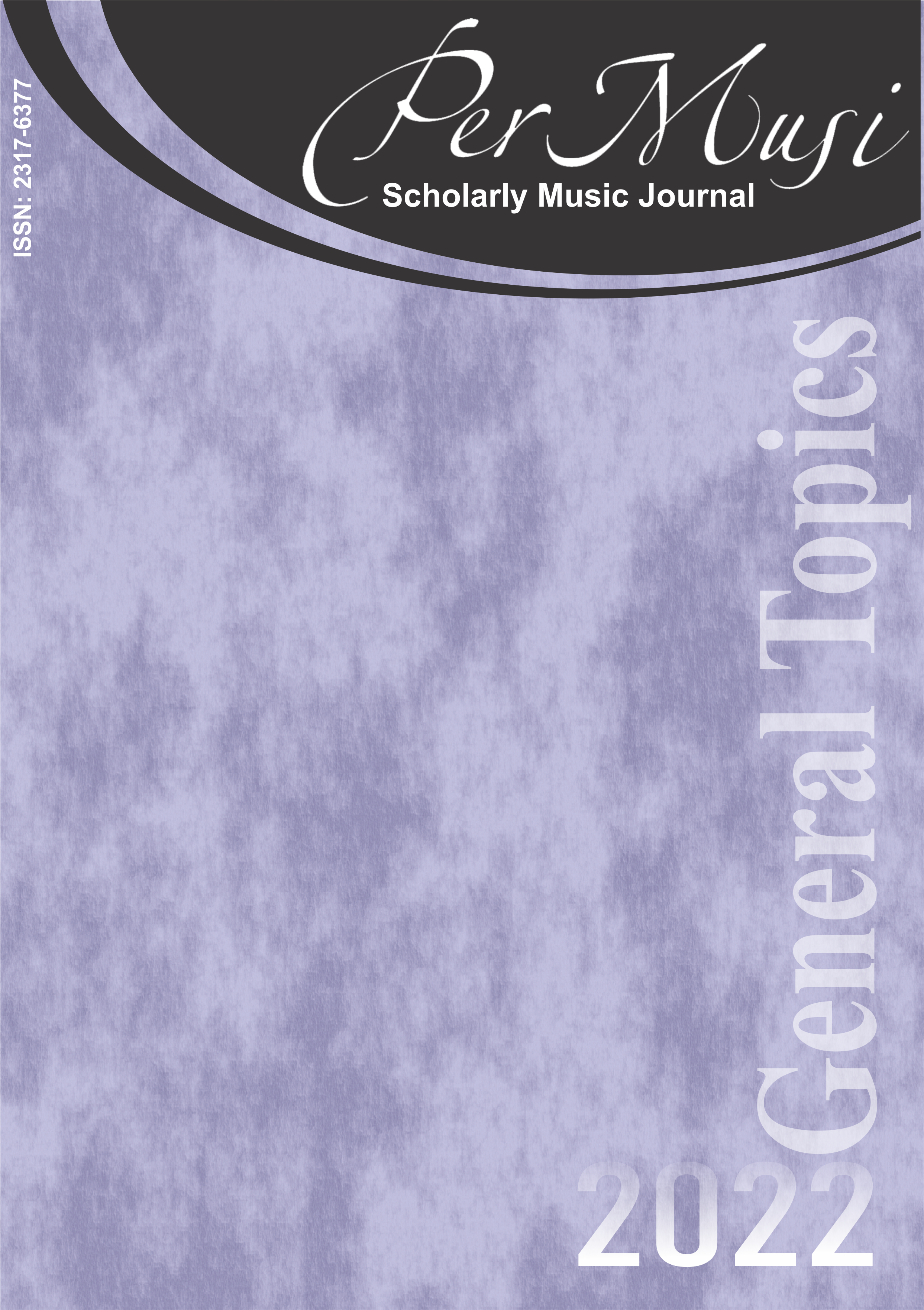Referências indonésias em Claviers de Iannis Xenakis
processo criativo com material exógeno em Pléïades (1978)
DOI:
https://doi.org/10.35699/2317-6377.2022.44450Palavras-chave:
Claviers, Iannis Xenakis, Pléïades, Música Indonésia, PercussãoResumo
O movimento Claviers foi composto para teclados de percussão e faz parte da obra Pléïades (1978) para seis percussionistas. Baseado em evidências de diferentes arquivos, destaca-se aqui relações diretas com elementos da música tradicional da Indonésia. Estas apontam para a inserção de materiais com os quais Xenakis teve contato nos anos 1950 e durante sua viagem para Bali e Java em 1972-1973. A inserção de material exógeno é bastante rara dentro da sua produção, mas em Claviers esta é uma parte substancial do processo criativo, trazendo significações particulares ao tratamento estrutural e à sequência de seções que caracteriza o movimento. Ao fazê-lo, o compositor cria então um discurso subjacente e um contexto bastante dinâmico dentro deste movimento em particular e isto aponta para correlações ainda não analisadas em uma parte mais ampla de sua produção. Este contexto dinâmico possui ainda implicações muito profundas com o pensamento e a prática composicional de Xenakis, trazendo novos elementos para a compreensão de parte do processo criativo durante uma fase bastante prolífica de sua vida.
Referências
Barthel-Calvet, Anne-Sylvie. 2000. “Le rythme dans l’œuvre et la pensée de Iannis Xenakis”. Tese de Doutorado, Escola de Estudos Avançados em Ciências Sociais (EHESS).
Barthel-Calvet, Anne-Sylvie. 2002a. “Temps et rythme chez Xenakis: le paradoxe de l’architecte”. In Portrait(s) de Iannis Xenakis, editado por François-Bernard Mâche, 159-169. Paris: Biblioteca Nacional da França.
Barthel-Calvet, Anne-Sylvie. 2002b. “Chronologie”. In Portrait(s) de Iannis Xenakis, editado por François-Bernard Mâche, 25-82. Paris: Biblioteca Nacional da França.
Bogler, Tilmann. 2017. “Xenakis - Pléïades Analyse von Rhythmus und Grafik”. Monografia de Bacharelado, Zurique: Escola Superior das Artes de Zurique.
Ceuster, Diederik Mark de. 2021. “‘Use 19 Metal Pieces of Approximately the Same Timbre’: An Analysis of Twelve Recorded Performances of Xenakis’s Métaux (Pléïades)”. Zeitschrift der Gesellschaft für Musiktheorie, 18 (1): 71-100.
https://www.gmth.de/zeitschrift/artikel/1106.aspx
Exarchos, Dimitris. 2007. “Iannis Xenakis and Sieve Theory: An Analysis of the Late Music (1984-1993).” Tese de Doutorado, Universidade de Londres.
Fleuret, Maurice. 1988. “Il teatro di Xenakis”. In Xenakis, editado por Enzo Restagno, 159-187. Torino: EDT.
Gibson, Benoît. 2001. “Théorie des cribles”. In Présences de Iannis Xenakis, editado por Makis Solomos, 85-92. Paris: CDMC.
Gibson, Benoît. 2011. The instrumental music of Iannis Xenakis. Theory, practice, self-borrowing. Hillsdale: Pendragon Press.
Halbreich, Harry. 1988. “Da “Cendrées” a “Waarg”: quindici anni di creatività”. In Xenakis, editado por Enzo Restagno, 211-270. Torino: EDT.
Harley, James. 2004. Xenakis. His Life in music. Nova Iorque: Routledge.
Lacroix, Marie-Hortense. 2001. Pléiades de Iannis Xenakis. Paris: Ed. TUM/Michel de Maule.
Mâche, François-Bernard. 1981. “Iannis Xenakis. Introduction aux œuvres”. In Regards sur Iannis Xenakis, editado por Hugues Gerhards, 153-166. Paris: Stock Musique.
Marandola, Fabrice. 2012. “Of Paradigms and Drums: Analyzing and Performing Peaux from Pléïades”. In Xenakis Matters, editado por Sharon Kanach, 185-204. Hillsdale: Pendragon Press.
Matossian, Nouritza. 1981. Iannis Xenakis. Paris: Fayard / Fondation SACEM.
Morais, Ronan Gil de. 2022. “Xenakis in Indonesia: Influences in the composition of Jonchaies (1977) and Pléïades (1978)”. In Centenary International Symposium XENAKIS 22: Lectures Workshops Concerts, editado por Anastasia Georgaki e Makis Solomos, 338-359. Atenas: Spyridon Kostarakis.
https://xenakis2022.uoa.gr/proceedings/
Morais, Ronan Gil de. 2023. “Iannis Xenakis’ SIX-XEN A new instrument for Pléïades (1978) and a creative process with Indonesian references”. Tese de Doutorado, Universidade da Basiléia e Escola de Música FHNW.
Morais, Ronan Gil de. & Araújo, Lucas Davi de. 2018. “Sixxen e música eletroacústica: o diálogo entre instrumento microtonal e aparatos eletroeletrônicos no repertório pós-Pléiades”. Revista Música, 18 (2): 8-29.
https://www.revistas.usp.br/revistamusica/article/view/147530
Morais, Ronan Gil de. Chaib, Fernando & Oliveira, Fabio. 2017. “Considerações históricas, estruturais e características sobre o instrumento Sixxen, de Iannis Xenakis”. Per Musi, 37: 1-21.
https://periodicos.ufmg.br/index.php/permusi/article/view/5164
Morais, Ronan Gil de. Chaib, Fernando & Oliveira, Fabio. 2020. “Repertório para Sixxen: a (re)definição de um novo instrumento através da composição”. Per Musi, 40: 1-22.
https://periodicos.ufmg.br/index.php/permusi/article/view/5296
Pires, Isabel. 2015. “Perspectives d’analyse comparative entre La Légende d’Eer et Jonchaies de Iannis Xenakis”. In Iannis Xenakis, La musique électroacoustique, editado por Makis Solomos, 29-52. Paris: L’Harmattan.
Porres, Alexandre Torres. 2007. “Processos de Composição Microtonal por meio do Modelo de Dissonância Sensorial.” Dissertação de Mestrado, Unicamp. https://www.repositorio.unicamp.br/acervo/detalhe/423727
Santana, Helena Maria da Silva. 1998. L’orchestration chez Iannis Xenakis : l’espace et le rythme, fonctions du timbre. Lille: ANRT.
Serrou, Bruno. 2003. L’homme des défis. Paris: CIG’ART/Jobert.
Solomos, Makis. 1996. Iannis Xenakis. Mercuès: P.O. Editions.
Solomos, Makis. 2002a. “Le « savant » et le « populaire », le postmodernisme et la mondialisation”. Musurgia, 9 (1): 75-89.
Solomos, Makis. 2002b. “Sculpter le son”. In Portrait(s) de Iannis Xenakis, editado por François-Bernard Mâche, 133-158. Paris: Biblioteca Nacional da França.
Spiller, Henry. 2004. Gamelan. The traditional sounds of Indonesia. Santa Barbara (USA): ABC-CLIO Inc.
Tenzer, Michael. 2011. Balinese Gamelan Music. Singapura: Tuttle.
Utz, Christian. 2018. “Transnationale Verflechtungen in der Musik der 1950er und 1960er Jahre: Henry Cowell, Toshirō Mayuzumi und Luciano Berio im Kontext des „Cultural Cold War”.” Archiv für Musikwissenschaft, 75 (2): 135-162.
Varga, Balint Andras. 1996. Conversations with Iannis Xenakis. Londres: Faber and Faber Ltd.
Veneración, Andrea. 1967. “International Music Symposium”. Ethnomusicology, 11 (1): 107-113.
Xenakis, Iannis. 1971. “Structures Hors-Temps.” In The Musics of Asia. Annals of the International Music Symposium, editado por José Maceda, 152-173. Manila: National Music Council of the Philippines and Unesco International Music Council.
Xenakis, Iannis. 1973. “Musique à Bali”. Programa de Radio (entrevista feita por P. A. Blachette; 29 de março, 1973). Paris: France Culture. Acessível pelos arquivos do Institut national de l'audiovisuel (Ina, França).
Xenakis, Iannis. 1979. Arts/Sciences. Alliages. Tournai: Casterman.
Partituras mencionadas
Xenakis, Iannis. 1977. Jonchaies. Paris: Éd. Salabert.
Xenakis, Iannis. 1979. Pléïades. 1ed. Paris: Éd. Salabert.
Xenakis, Iannis. 1981. Komboï. Paris: Éd. Salabert.
Xenakis, Iannis. 2013. Pléïades. 2ed. Paris: Éd. Salabert.
Publicado
Edição
Seção
Licença
Copyright (c) 2023 Per Musi

Este trabalho está licenciado sob uma licença Creative Commons Attribution 4.0 International License.

Exceto onde está indicado, o conteúdo neste site está sob uma Licença Creative Commons - Atribuição 4.0 Internacional.












